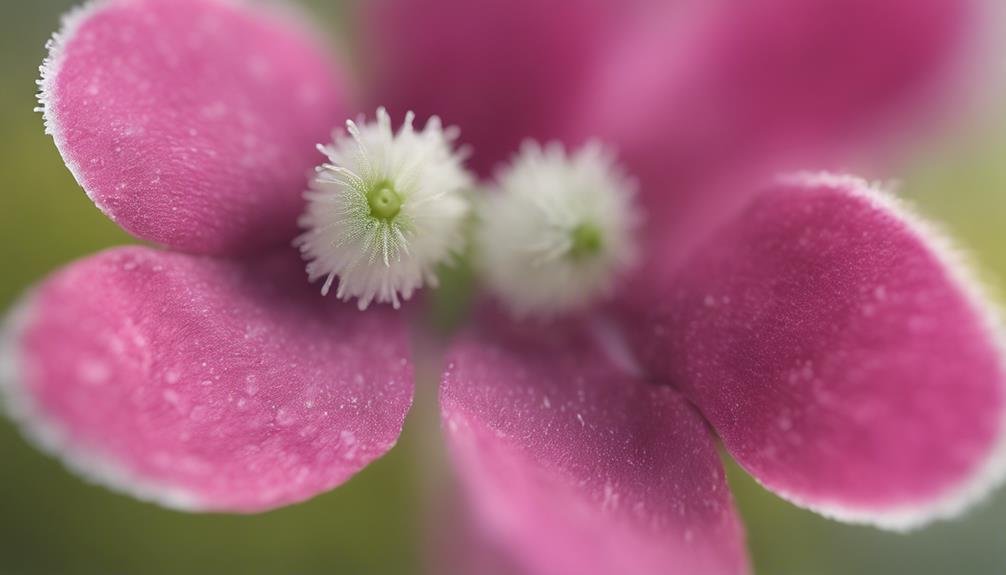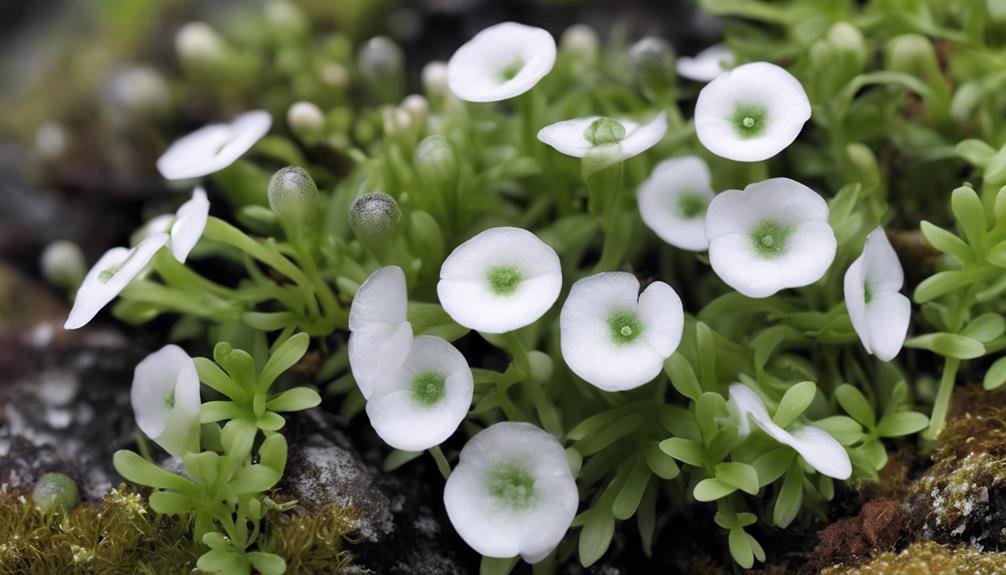How does Diapensia lapponica adapt to survive in the challenging conditions of alpine environments? This question opens up a fascinating area of study into the resilience of alpine flora. Diapensia lapponica, a perennial plant, has developed unique adaptations that enable it to thrive in its harsh habitats.
In the heart of alpine ecosystems, where the climate is unforgiving, the survival strategies of Diapensia lapponica are not only intriguing but vital for understanding ecological balance. This plant’s cushion-like structure, stemming from its densely packed leaves, acts as an insulation layer. This unique form minimizes moisture loss and shields the plant from extreme cold, playing a critical role in its survival. The presence of its flowers, which range in color from white to occasionally pink-tinged, adds not only beauty to the alpine landscapes but also serves an important function by providing a pollen source for insects in these nutrient-scarce regions.
However, the increasing global temperatures pose a significant threat to the specialized habitats of Diapensia lapponica. This situation calls for an examination of how these environments, and the plants that inhabit them, will adapt to changing conditions. The study of Diapensia lapponica‘s adaptability offers a window into the potential impacts on alpine ecosystems, highlighting the urgent need for understanding and preserving these unique ecological niches.
Key Takeaways
Diapensia lapponica thrives in extreme Arctic-alpine environments, showcasing its remarkable adaptation through a compact growth form and robust foliage that minimize water loss and withstand freezing temperatures.
This plant is crucial for the survival of specific alpine insects, offering them a necessary pollen source and underscoring its ecological importance.
The survival and habitat of Diapensia lapponica are under threat due to climate change, highlighting the urgent need for conservation efforts to protect these vulnerable ecosystems and maintain the plant’s ecological role.
Arctic-Alpine Plant Spotlight
Resilience in the Face of Extremity: Diapensia lapponica
In the stark and unforgiving landscapes of arctic-alpine regions, the Diapensia lapponica emerges as a testament to the power of nature’s adaptability. This evergreen shrub, with its cushion-like form, showcases an incredible capacity to endure and flourish under extreme weather conditions. Its specialized structure isn’t merely a physical characteristic but a survival strategy, ingeniously designed to combat the relentless cold winds and retain warmth.
A Tale of Two Subspecies: Lapponica and Obovata
The existence of Diapensia lapponica is further diversified into two subspecies, lapponica and obovata, each with its own unique distribution range. This differentiation highlights the plant’s remarkable ecological flexibility, allowing it to thrive across varied alpine niches. The ability of these subspecies to adapt to different environments speaks volumes about the evolutionary paths and mechanisms that have enabled Diapensia lapponica to conquer the challenges of alpine existence.
The Indicator of Environmental Shifts
In the delicate balance of arctic-alpine ecosystems, Diapensia lapponica stands as a sensitive gauge for temperature fluctuations and environmental changes. Its presence and health can signal shifts within the ecosystem, making it an invaluable species for scientists and conservationists. The study and protection of this plant aren’t just about preserving a species but about understanding the broader implications of change in alpine environments.
The Call for Conservation
Protecting Diapensia lapponica is a task that requires attention and action to address threats like habitat trampling and the overarching challenge of global climate change. Conservation efforts are crucial in safeguarding not only this unique species but also the intricate web of life that depends on arctic-alpine ecosystems. It’s a reminder of our responsibility toward maintaining the health and diversity of our planet’s environments.
Flower Characteristics

Flower Description and Habitat
The Diapensia lapponica sports white or, in rarer instances, pink flowers. Each flower is distinguished by its five lobes, indicative of the plant’s unique beauty and intricate design. These blooms perch individually atop stems no taller than 3cm, a testament to the plant’s compact and resilient nature. The flowering season, spanning from May through August, marks a period of vibrant activity in the alpine regions of New England, where these plants make their home.
Reproductive Significance
The blossoming of Diapensia lapponica is more than a visual spectacle; it’s a critical phase in the plant’s life cycle. The solitary flowers atop their slender stems aren’t just for show; they’re crucial for the plant’s reproduction. The timing and structure of these flowers are fine-tuned adaptations that aid in efficient pollination. Despite their apparent fragility, these adaptations ensure the species’ propagation and continued survival in the challenging alpine terrain.
Adaptations to Alpine Conditions
Living in harsh alpine environments demands exceptional resilience and adaptability, traits that Diapensia lapponica possesses in abundance. The plant’s bloom cycle, aligning with the warmer months, ensures that pollinators are active and available, maximizing reproductive success. The delicate balance of life in these demanding habitats is vividly illustrated by the plant’s lifecycle, showcasing nature’s ingenuity in sustaining life under the most challenging conditions.
Global Range Insights

Global Distribution of Diapensia lapponica
The circumboreal distribution of Diapensia lapponica showcases its remarkable ability to adapt to different cold environments worldwide. This species, with its subspecies lapponica and obovata, spans an impressive range from eastern North America to eastern Arctic Russia, including regions like Korea, Japan, and Alaska. The lapponica variety is particularly noted in New York, highlighting its presence within North America. In contrast, obovata is more prevalent in Arctic Russia, Korea, and Japan.
Unique Habitats and Adaptations
Diapensia lapponica flourishes in alpine regions, favoring bare ledges and gravelly terrains. It often forms dense cushions and mats, thriving above the treeline on rocky ridges exposed to high winds that keep the snow at bay. This preference for rocky habitats underscores the plant’s sensitivity to temperature fluctuations, showcasing its specialization in these environments.
Historical Dispersal and Resilience
The distinct geographical ranges of Diapensia lapponica’s subspecies, without overlap in north central Canada or central Siberia, point to a historical separation. This separation likely occurred due to dispersal following varying glacial periods, demonstrating the species’ resilience and adaptability to extreme cold conditions.
Pollen Source for Insects

Pollen Source and Alpine Ecosystem Vitality
The white blooms of Diapensia lapponica play a pivotal role in the alpine environments by providing a critical pollen source for various insects. These creatures, including bees and butterflies, depend on the plant for both nectar and pollen, highlighting the essential nature of Diapensia lapponica in nurturing alpine biodiversity. The allure of these white flowers to an array of insect pollinators isn’t just about beauty; it ensures the plant’s reproductive success and perpetuates this delicate ecological balance.
The Role of Insect Pollinators
- Bees are indispensable for cross-pollination, contributing to the genetic diversity within the alpine flora. Their work ensures the health and resilience of plant populations.
- Butterflies, through their pollination efforts, play a significant part in the reproduction processes of many alpine plants, intertwining their survival with the flora they frequent.
- Other insects enrich the pollination network, bolstering the ecosystem’s health and diversity. Their collective efforts are fundamental to the thriving alpine ecosystems, which rely heavily on pollinators for the continued reproduction of various plant species, including Diapensia lapponica.
Interconnectedness in Alpine Ecosystems
The symbiotic relationship between Diapensia lapponica and its insect visitors underscores the plant’s vital position within its habitat. Pollen from Diapensia lapponica not only sustains the diverse insect populations that inhabit these regions but also plays a significant role in maintaining the health and sustainability of the alpine environment itself. This dynamic interaction exemplifies the importance of preserving plant-insect interactions for the overall vitality of alpine ecosystems, emphasizing the interconnectedness of life at high altitudes.
Vulnerable Habitats

Role of Diapensia Lapponica in Alpine Ecosystems
The Diapensia lapponica plays a critical role in maintaining the ecological balance of alpine summits. These plants are adapted to thrive in the harsh conditions of exposed rocky ridges, contributing significantly to the biodiversity above the treeline. Their ability to form dense cushions makes them a key species in these ecosystems.
Threats to Alpine Habitats
Despite the resilience of Diapensia lapponica, the very environments that foster its growth are under threat. The fragile nature of alpine summits makes them vulnerable to disturbances, especially from hiker traffic. This activity can lead to significant trampling damage, endangering the Diapensia populations and, by extension, the habitats they support.
Conservation Efforts and Legal Protection
Initiated in 1980, monitoring efforts at a site near Glenfinnan in Lochaber have shown a stable population of Diapensia lapponica. This stability, however, doesn’t diminish the plant’s vulnerability status. Recognized in the British vascular plant Red Data Book and protected under Schedule 8 of the Wildlife and Countryside Act 1981, Diapensia lapponica receives legal protection that highlights the importance of continued monitoring and conservation efforts.
These actions are pivotal for ensuring the preservation of alpine biodiversity and the protection of these sensitive habitats.
Frequently Asked Questions
What Is the Common Name for Diapensia Lapponica?
Q: What is the common name for Diapensia Lapponica?
A: The common name for Diapensia Lapponica is Lapland Diapensia. This name reflects its growth form and its native habitat in the cold, mountainous regions of Lapland.
How Does the Tundra Rose Compare to Diapensia in Adapting to Harsh Arctic Environments?
The tundra rose and Diapensia are both adapted to survive in the harsh Arctic environment. Tundra rose characteristics include a low-growing form, hairy leaves, and the ability to store energy efficiently, while Diapensia thrives through a cushion-like growth to resist cold temperatures and dry, wind-swept conditions.
What Are the Key Differences in Habitat Preferences Between Diapensia and Tufted Saxifrage?
Diapensia thrives in harsh, windswept alpine environments with rocky and well-drained soils, preferring areas with minimal competition. In contrast, the tufted saxifrage plant favors moist, rocky crevices at slightly lower elevations, where it can access shade and more consistent moisture. Both plants demonstrate unique adaptations to their specific habitats.
Conclusion
To sum up, Diapensia lapponica stands out as a resilient plant, adeptly adapted to the severe conditions of its Arctic-alpine habitat. Its compact growth form and tough foliage are specifically evolved to reduce water loss and endure the freezing temperatures typical of its environment.
This plant plays a pivotal role in its ecosystem, serving as a vital source of pollen for certain alpine insects, thus emphasizing its ecological significance. Yet, the future of Diapensia is imperiled by the ongoing threat of climate change, which places its habitat and survival in jeopardy.
This situation calls for a heightened focus on preserving these delicate ecosystems to safeguard the persistence and ecological function of Diapensia lapponica and similar species.


